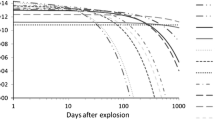Abstract
Eight liquid effluent samples from nuclear power plants (NPP) were analyzed for 63Ni, 131I, and gamma radionuclides using methods with low detection limits. The sum of the radionuclides activity concentrations of the effluent samples from NPPs A and B were closely lower than the operator’s results with a maximum of decreasing to 29%, while from NPP C were much lower with a maximum of decreasing to 5%. The unlisted radionuclides account for 5.0–889%. It was indicated that the statistics method of the discharge amount could be established based on a regular investigation of the radionuclide characteristics based on analytical methods with low limits of detection.



Similar content being viewed by others
References
IAEA (2010) IAEA Safety Standards Series No. 64 Programmes and systems for source and envrionmental radiation monitoring. International Atomic Energy Agency, Vienna
IAEA (2018) IAEA Safety Standards Series No. GSG-9 regulatory control of radioactive discharges to the environment. International Atomic Energy Agency, Viena
Zorko B, Korun M, Mora Canadas JC, Nicoulaud-Gouin V, Chyly P, Blixt Buhr AM, Lager C, Aquilonius K, Krajewski P (2016) Systematic influences of gamma-ray spectrometry data near the decision threshold for radioactivity measurements in the environment. J Environ Radioact 158–159:119–128. https://doi.org/10.1016/j.jenvrad.2016.04.009
Ministry of Environmental Protection PR China (2011) GB 6249-2011 regulations for environmental radiation protection of nuclear power plant. General Administration of Quality Supervision, Inspection and Quarantine of China, Beijing
Yuan Z-L, Pan Z-Q, Zhang Y-X, Chen X-Q, Li H-Y, Huang D-H (2015) Discussion on low-level radionuclide monitoring for nuclear power plant effluent (in Chinese). Radiat Prot 35(1):1–8
Yuan Z-L, Zhao S-G (2010) Discussion on issues in the effluent monitoring and environmental monitoring of nuclear facilities (in Chinese). Nucl Saf 3:42–45
Yang D-J, Wei X-Y, Fang Y, Li Y (2018) The record method for radioactive materials released in liquid effluents from PWR nuclear power plants (in Chinese). Radiat Prot 38(3):186–190
Union European (2004) 2004/2/Euratom on standardised information on radioactive airborne and liquid discharges into the environment from nuclear power reactors and reprocessing plants in normal operation. European Union, Brussels
USNRC (2009) Measuring, evaluating, and reporting radioactive material in liquid and gaseous effluents and solid waste; regulatory guide 1.21, Revision 2. United States Nuclear Regulatory Commission, Washington
Choi NY, Cheong JH (2019) A priori risk-informed approach to ensure the compliance with discharge limits for liquid radioactive effluent to be discharged from APR 1400. J Nucl Sci Technol 56(1):41–54. https://doi.org/10.1080/00223131.2018.1523755
Shang-Guan Z-H, Huang Y-J, Sha X-D, Wu L-S, Chen C-F (2017) Investigation on discharge, dose assessment and monitoring methods of 63Ni in liquid effluents from nuclear power plant (in Chinese). Radiat Prot 37(6):445–452
Ministry of Environmental Protection (2017) HJ 841-2017 analytical method for 131I in water, milk, plant and animal thyroid gland. Ministry of Environmental Protection, Beijing
State Bureau of Technical Supervision (1993) GB/T 14502-93 analytical method of nickel-63 in water. State Bureau of Technical Supervision, Beijing
General Administration of Quality Supervision Inspection and Quarantine of the People’s Republic of China (2018) GB/T 16140-2018 determination of radionuclides in water by gamma spectrometry. Beijing, China
Curti E (1997) Coprecipitation of radionuclides: basic concepts, literature review and first applications (No. PSI—97-10). Paul Scherrer Inst.(PSI)
Jan F, Aslam M, Orfi SD, Hussain M (2005) Separation of radionuclides of silver and antimony from low-level liquid waste of research reactor by using iron(II) hydrous oxide coprecipitation. Sep Sci Technol 39(5):1021–1036. https://doi.org/10.1081/SS-120028569
Jan F, Aslam M, Orfi SD, Wahid A (2004) Removal of silver and antimony radionuclides from low-level liquid radioactive waste of a research reactor through different scavenging precipitations. Radiochim Acta 92(7):433–438
Strom DJ, Stansbury PS (1992) Minimum detectable activity when background is counted longer than the sample. Health Phys 63(3):360–361. https://doi.org/10.1097/00004032-199209000-00016
Currie LA (1984) NUREG/Cr-4007 lower limit of detection: definition and elaboration of a proposed position for radiological effluent and environmental measurements. USNRC, Washington
IAEA (2003) IAEA-TECDOC-1340 manual for reactor produced radioisotopes. International Atomic Energy Agency, Vienna
Ponsard B, Srivastava SC, Mausner LF, Knapp FF, Garland MA, Mirzadeh S (2009) Production of Sn-117m in the BR2 high-flux reactor. Appl Radiat Isot 67(7):1158–1161. https://doi.org/10.1016/j.apradiso.2009.02.023
IUPAC (2020) Commission on Isotopic Abundances and Atomic Weights (CIAAW), Atomic masses. http://www.ciaaw.org/atomicmasses.htm
Rudling P, Adamson RB (2013) 5—performance and inspection of zirconium alloy fuel bundle components in light water reactors (LWRs). In: Murty KL (ed) Materials ageing and degradation in light water reactors. Woodhead Publishing, Cambridge, pp 246–283. https://doi.org/10.1533/9780857097453.2.246
Yau TL, Annamalai VE (2016) Corrosion of zirconium and its alloys. In: Lauter V, Lauter H, Glavic A, Toperverg B (eds) Reference module in materials science and materials engineering. Elsevier, Amsterdam. https://doi.org/10.1016/B978-0-12-803581-8.01641-6
European Union, the European Commission RAdioactive Discharges Database (2020) https://europa.eu/radd/
Sha X-D, Huang Y-J, Zeng F, Shang-Guan Z-H, Jiang J, Wu L-S, Cao Z-G, Chen C-F (2020) An investigation of the liquid effluent discharge and analytical methods of 55Fe from PWRs of nuclear power plant. Radiat 55 Prot 40(5):394–401
Author information
Authors and Affiliations
Corresponding author
Ethics declarations
Conflict of interest
The authors declare that they have no conflict of interest.
Additional information
Publisher's Note
Springer Nature remains neutral with regard to jurisdictional claims in published maps and institutional affiliations.
Rights and permissions
About this article
Cite this article
Huang, YJ., Zeng, F., Jiang, J. et al. A statistical evaluation of the liquid effluent release from NPP based on analytical methods with low detection limits. J Radioanal Nucl Chem 327, 801–810 (2021). https://doi.org/10.1007/s10967-020-07569-9
Received:
Accepted:
Published:
Issue Date:
DOI: https://doi.org/10.1007/s10967-020-07569-9




